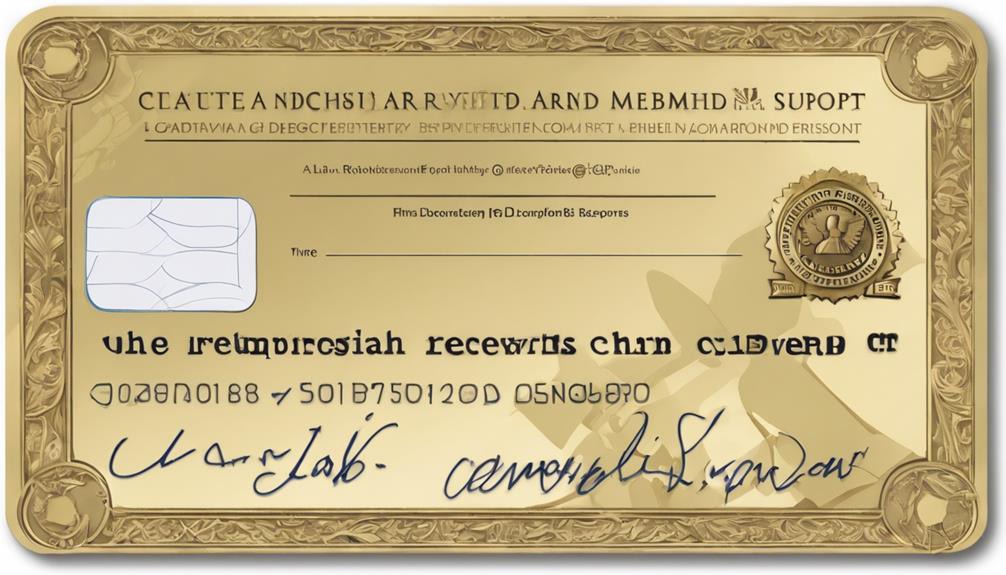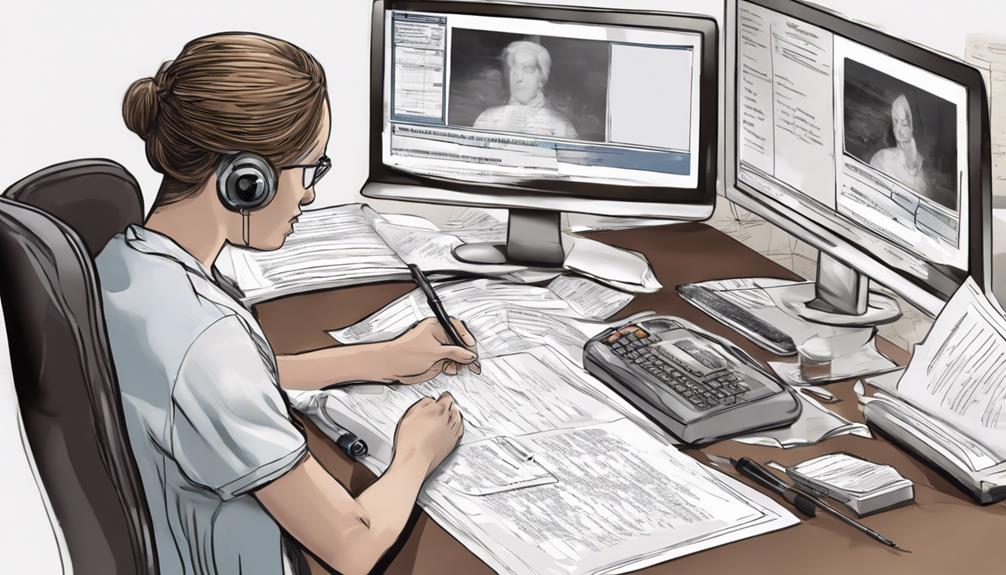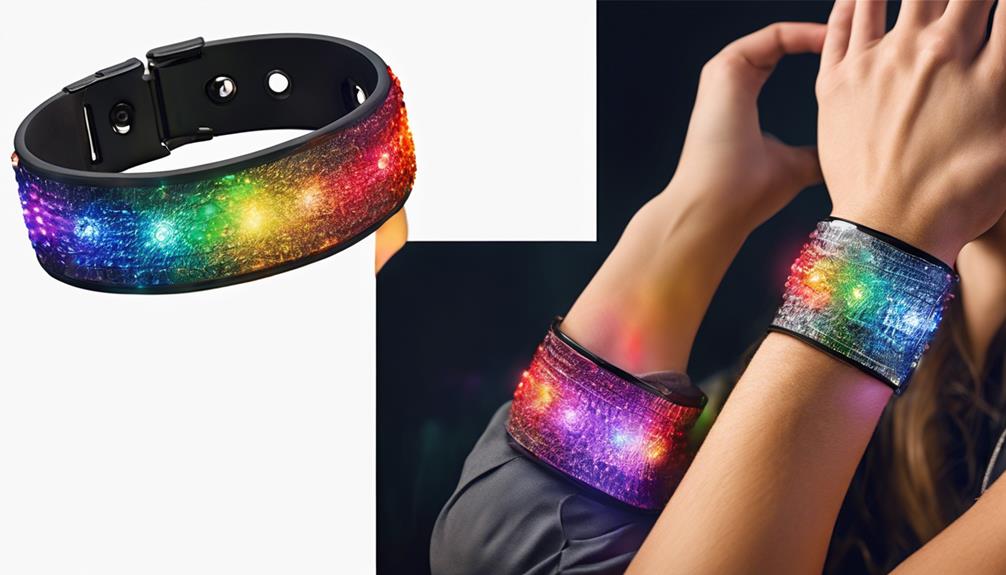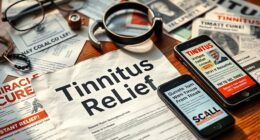As individuals aspiring to become interpreters, you might not yet understand the complex steps required to register with the Registry of Interpreters for the Deaf (RID).
Understanding the nuances of certification, preparing effectively for exams, and navigating the application process are just the tip of the iceberg.
These 10 essential tips encompass everything from documentation requirements to seeking support and resources.
Stay tuned to uncover the key strategies that can elevate your journey towards becoming a certified interpreter with the RID.
Key Takeaways
- Understand exam criteria and eligibility requirements for successful registration.
- Utilize available study resources and practice ethical standards.
- Stay updated with continuing education for professional growth and certification maintenance.
- Ensure clear documentation and timely payment of fees for a smooth registration process.
Documentation Requirements
Our registration process with the Registry of Interpreters for the Deaf requires us to provide a comprehensive set of documentation to verify our qualifications and credentials. This includes proof of RID certification, if applicable, which serves as a testament to our proficiency in sign language interpretation.
Additionally, we must submit documentation of completed interpreter training programs to showcase our foundational knowledge and skills in this field. Demonstrating our commitment to continuous learning, we're also asked to include proof of completion of required continuing education units (CEUs) to stay current with best practices and industry developments.
Moreover, submitting any relevant transcripts or degrees related to interpreting helps to provide a holistic view of our educational background. It's crucial that all required documentation is clear, accurate, and up to date to streamline the registration process and ensure our qualifications align with the stringent standards set by the Registry of Interpreters for the Deaf.
Understanding Exam Criteria

When preparing to take the RID certification exams, it's crucial to understand the exam criteria thoroughly.
We'll cover essential points such as the eligibility requirements candidates must meet, an overview of the test format, and the resources available for study.
Familiarizing ourselves with these aspects will help us approach the exams confidently and increase our chances of success.
Exam Eligibility Requirements
Understanding the eligibility requirements for the Registry of Interpreters for the Deaf certification exams is crucial for prospective interpreters. Meeting the exam eligibility criteria is a vital step towards certification. These requirements vary depending on the certification sought, such as NIC or CDI.
Prospective interpreters must meet specific criteria related to education, experience, and training to qualify for the exams. The RID's certification exams are designed to assess different skill levels and knowledge based on the type of certification being pursued. Fulfilling the exam eligibility requirements is essential for a successful registration process with the Registry of Interpreters for the Deaf.
Prospective interpreters should carefully review and understand the exam criteria to ensure they meet all necessary qualifications for certification.
Test Format Overview
To comprehend the test format for RID certification exams thoroughly, interpreters must be familiar with both the written and performance components. The exams cover a wide range of topics, including interpreting theories, ethics, and professional practices. Practical skills are evaluated through performance exams in various settings like medical or legal environments. Understanding the exam criteria is crucial for effective preparation.
Test Format Overview:
- Written exams assess knowledge of interpreting theories, ethics, and professional practices.
- Performance exams evaluate practical interpreting skills in medical and legal settings.
- Exams are designed to ensure interpreters meet the required standards for certification.
Study Resources Available
Moving from the overview of the test format, exploring the study resources provided by the Registry of Interpreters for the Deaf (RID) can greatly benefit candidates preparing for the certification exam. RID offers a variety of resources such as study guides, practice exams, and online materials to assist in exam preparation.
Understanding the exam content outline provided by RID is essential for a focused study approach. By familiarizing oneself with the specific skills and knowledge areas assessed in the exam, candidates can better target their preparation efforts.
Utilizing RID's recommended preparation materials can significantly enhance one's chances of success in meeting the exam criteria. These resources are valuable tools for interpreters aiming to excel in the certification process.
Application Process Overview

The application process for registering with the Registry of Interpreters for the Deaf (RID) involves gathering and submitting the necessary documentation to demonstrate qualifications and credentials.
To successfully complete the application process, applicants must:
- Meet Specific Qualifications: Applicants need to ensure they meet the qualifications set by RID, which may include educational requirements and experience in the field of interpreting.
- Provide Proof of Certification or Credentials: Applicants must submit proof of certification or credentials to demonstrate their proficiency and competency in sign language interpretation.
- Demonstrate Compliance with RID's Standards: It's essential to show compliance with RID's standards by completing all required forms accurately, paying the necessary fees, and adhering to the organization's guidelines.
Exam Preparation Strategies

Exploring effective strategies for preparing for the examination is crucial for success in obtaining certification with the Registry of Interpreters for the Deaf (RID). To excel in the certification exam, it is essential to review the CASLI Exam Content Outline meticulously, ensuring a comprehensive understanding of the exam structure and content areas. The CASLI Preparation Guide offers valuable insights and tips for effective studying and preparation. Engaging in practice interpreting across various settings is fundamental for enhancing interpreting skills and proficiency. Familiarizing oneself with the certification exam requirements and eligibility criteria is vital for adequate preparation. Seeking feedback from experienced interpreters or mentors can significantly contribute to improving interpreting abilities and performance. Utilize the resources available to you to enhance your skills and increase your chances of success in the registration with RID.
| Exam Preparation Strategies | ||
|---|---|---|
| Review CASLI Exam Content Outline | Utilize CASLI Preparation Guide | Practice interpreting in various settings |
| Familiarize with certification exam requirements | Seek feedback from mentors | Improve interpreting skills |
Membership Benefits

After mastering exam preparation strategies, understanding the membership benefits of registering with the Registry of Interpreters for the Deaf (RID) becomes essential for interpreters seeking professional growth and support. Joining RID offers a range of advantages that are crucial for interpreters looking to excel in their careers:
- Access to Certified Interpreters Database: RID membership provides access to a comprehensive database of certified interpreters, enabling members to connect with other professionals in the field and collaborate on various projects.
- Enhanced Credibility and Marketability: Being part of RID enhances interpreters' credibility and marketability, as it signifies a commitment to upholding ethical standards and best practices in the field, which can attract potential clients and employers.
- Ongoing Professional Development Opportunities: RID membership ensures ongoing professional development and career advancement opportunities, supporting interpreters in staying updated with the latest industry trends and refining their skills through workshops, conferences, and training sessions.
Additionally, being part of RID facilitates networking, allowing interpreters to build relationships within the interpreting community and expand their professional connections.
Code of Ethics Familiarization

Familiarizing ourselves with the Code of Ethics is paramount for interpreters to uphold professional standards in their work with the Deaf community. The NAD-RID Code of Professional Conduct serves as a cornerstone, offering clear guidance on ethical standards, professional behavior, confidentiality, and transparency in interpreting practice. Adherence to these principles is crucial for maintaining trust and credibility within the Deaf community.
Interpreters must thoroughly understand and internalize the Code of Professional Conduct to ensure they navigate complex ethical dilemmas effectively. Violations of these ethical standards can have serious consequences, potentially leading to disciplinary action by RID. By familiarizing themselves with the Code of Ethics, interpreters demonstrate their commitment to upholding the highest standards of professionalism in their interactions with Deaf individuals.
Incorporating the principles outlined in the NAD-RID Code of Professional Conduct into daily practice not only safeguards the integrity of the interpreting profession but also fosters a culture of respect and inclusivity within the Deaf community.
Continuing Education Importance

To maintain their certification with RID, interpreters must actively engage in continuing education to stay abreast of industry trends and enhance their professional skills. Continuing education is vital for certified members as it ensures they remain current with evolving industry trends and adopt best practices. This ongoing professional development not only benefits the interpreters themselves but also supports career advancement opportunities within the field.
Importance of Continuing Education:
- Professional Development: Engaging in continuing education allows interpreters to expand their knowledge and skills, contributing to their overall professional growth.
- Career Advancement: Staying updated with industry trends through ongoing education opens doors to new opportunities and advancements in one's interpreting career.
- Certification Maintenance Program (CMP): RID's CMP facilitates interpreters in meeting their continuing education requirements, guiding them towards maintaining their certification and staying competitive in the field.
Financial Considerations

When considering registering with the Registry of Interpreters for the Deaf, it's crucial to understand the fee structure options and payment deadlines. RID membership fees vary depending on the chosen category, ranging from $70 to $180 annually.
Certification exam fees and maintenance costs also play a significant role in the financial considerations for aspiring interpreters.
Fee Structure Options
Navigating the financial aspects of registering with the Registry of Interpreters for the Deaf involves understanding the varying fee structures in place for different membership types and services offered. When considering fee structures with RID, individuals should take into account the following:
- RID membership fees can range from $35 to $275 annually, depending on the type of membership chosen.
- Certification maintenance fees for RID members vary from $55 to $175 per year.
- Exam fees for RID certification exams range from $175 to $325 per exam.
These fees are subject to change and additional charges may apply for late renewals, reinstatements, and special services. It's essential to stay informed about the fee structure options to make well-informed decisions.
Payment Deadlines
Understanding the importance of meeting payment deadlines is crucial for ensuring a smooth registration process with the Registry of Interpreters for the Deaf. Payment deadlines for RID registration typically fall within 30 days of the invoice date. Late payments may incur additional fees or penalties, impacting the registration process. Timely payment is essential to secure registration and access RID's benefits and services. Registration fees vary based on membership category and certification status. Failure to meet payment deadlines may result in delays or denial of registration privileges.
| Membership Category | Certification Status | Payment Deadlines |
|---|---|---|
| Student | Associate | 30 days |
| Certified | Certified | 30 days |
| Supporting | Provisional | 30 days |
Exam Scheduling Tips

To schedule your RID certification exam through the CASLI website, plan in advance to secure your preferred exam date and location. When scheduling your exam, consider the following tips:
- Check Registration Deadlines: Stay informed about the registration deadlines to ensure you don't miss the opportunity to sit for the exam.
- Verify Eligibility Requirements: Before scheduling your exam, make sure you meet all the eligibility requirements set by the RID to avoid any issues later on.
- Utilize CASLI Exam Content Outline: Use the CASLI Exam Content Outline as a guide to prepare effectively for your exam. Familiarizing yourself with the content outline can help you focus your study efforts on the relevant topics.
Seeking Support and Resources

As we navigate the process of registering with the Registry of Interpreters for the Deaf, it's crucial to seek support and utilize available resources.
Accessing community resources and connecting with peer networks can enhance our professional growth and provide valuable insights.
Accessing Community Resources
For accessing community resources and seeking support, one effective strategy is to utilize the National Registry of Interpreters for the Deaf (RID) online database. This database can help in finding qualified interpreters for various needs.
Additionally, referrals from the state office for the Deaf and Hard of Hearing can provide valuable information about local community resources available to the Deaf. When searching for interpreters, starting early is crucial to ensure availability.
Small businesses can benefit from tax credits to help cover interpreter expenses, making it easier to provide necessary services. It's important to be aware that charging surcharges for interpreter costs is against regulations, so businesses must explore alternative funding options.
Connecting With Peer Networks
Joining the Registry of Interpreters for the Deaf (RID) opens doors to a supportive network of peers and professionals in the sign language interpreting field, providing valuable resources for professional growth.
Engage with local RID chapters and interpreting communities to establish connections and access essential information. Participation in RID events, workshops, and conferences allows for networking with colleagues and staying abreast of industry trends.
Utilize RID's online platforms and forums to connect with fellow members, share experiences, and seek advice. Collaborating with other RID members facilitates the exchange of knowledge, resources, and best practices for ongoing professional development.
RID offers a vibrant community that fosters learning, support, and collaboration, essential for interpreters navigating the complexities of the interpreting field.
Frequently Asked Questions
What Are the 4 Most Important Qualities an ASL Interpreter Should Have?
We believe the four most important qualities an ASL interpreter should possess are:
- Fluency in American Sign Language,
- Strong cultural competency in Deaf culture,
- Excellent listening and observation skills, and
- Adherence to professional ethics.
These attributes are crucial for effective communication, building rapport, accurately interpreting messages, and maintaining integrity.
As interpreters, we strive to embody these qualities to provide quality interpretation services.
What Are the 7 Tenets of the Cpc?
We interpret like dancers on stage, guided by the 7 tenets of the CPC. These ethical guidelines encompass confidentiality, professionalism, competence, integrity, respect, beneficence, and professional development.
Adhering to these principles is crucial for maintaining professionalism and upholding the values of our profession. The CPC acts as a compass, helping us navigate ethical decisions and deliver quality interpreting services.
What Are the Two Types of Interpreter Certifications Granted by Rid?
We grant two types of interpreter certifications:
National Interpreter Certification (NIC) for hearing interpreters working with Deaf and hard of hearing individuals. NIC focuses on interpreting skills and requires passing specific exams.
Certified Deaf Interpreter Certification (CDI) for Deaf individuals who interpret. CDI emphasizes cultural and linguistic nuances in the Deaf community and requires passing specific exams.
Both certifications meet rigorous standards to ensure qualified interpreters who adhere to professional and ethical practices.
What Is NIC Certification?
NIC certification, offered by RID, validates interpreters' skills in various settings. It signifies a dedication to professional standards and ethics, paving the way for credibility in the field.
As sign language interpreters, earning this certification equips us with the tools needed to excel and provide quality service to the Deaf community. Remember, 'Practice makes perfect' as we strive for excellence in our craft.
Conclusion
In conclusion, registering with the Registry of Interpreters for the Deaf is a crucial step for interpreters looking to enhance their skills and credibility.
Did you know that over 15,000 interpreters are currently certified with RID, providing valuable services to the Deaf community nationwide?
Take the necessary steps to join this esteemed registry and make a positive impact in the field of sign language interpretation.











